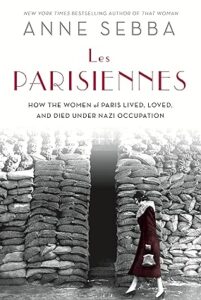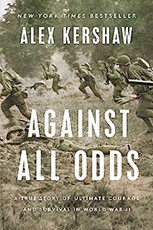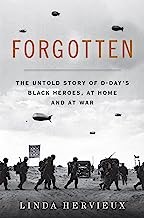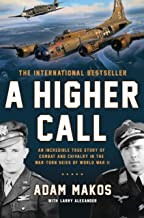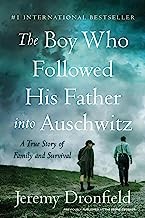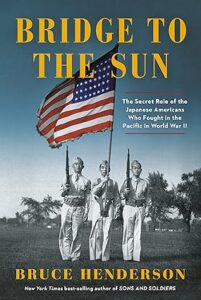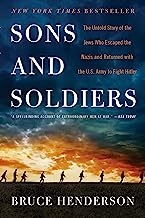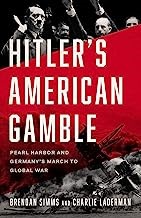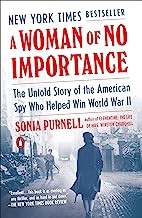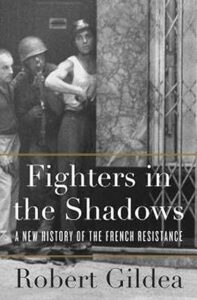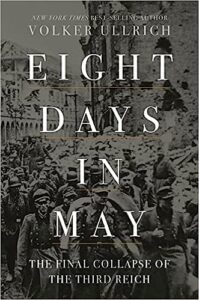U.S. EIGHTH AIR FORCE ACTIVATED
Savannah, Georgia • January 28, 1942
On this date in 1942 the fledgling U.S. Eighth Air Force was activated at Savannah Air Force Base in Georgia. Second-in-command Brig. Gen. Ira Eaker was sent to England to form and organize its bomber command, the VIII Bomber Command. An advanced detachment was established at RAF Bomber Command Headquarters in Southeast England. For nearly 2 years Eaker’s name was synonymous with the Eighth Air Force. He became the architect of a strategic bombing force that ultimately numbered 40 groups of 60 heavy bombers each, supported by a subordinate fighter command of 1,500 aircraft, the VIII Fighter Command.
The Eighth Air Force operated over Northern Europe, carrying out daylight “precision” bombings of enemy targets in occupied France and the Low Countries and in Nazi Germany. Regular combat operations by VIII Bomber Command began on August 17, 1942, when 12 B‑17 Flying Fortresses attacked railroad yards at Rouen in Northwestern France, roughly 40 miles/64 km inland from the English Channel. (That first daylight sortie was only partially successful: half the bombs fell within the rail yard, but many fell outside the aiming point, killing 52 civilians and wounding 120.) In late February 1944 VIII Bomber Command and Ninth Air Force were brought under control of a centralized headquarters. That same week, “Big Week” (February 20–25, 1944), over 1,000 B‑17s and B‑24 Liberators and over 800 fighters of the Eighth Air Force targeted the German aircraft industry. Their raids in February and March 1944 caused so much damage that the Germans were compelled to disperse aircraft manufacturing eastward, to safer parts of the Reich.
Less than a week after “Big Week,” the Eighth Air Force sent over 700 heavy bombers, accompanied by 800 escort fighters, to hit targets in Berlin, dropping the first American bombs on Adolf Hitler’s capital.
Beginning May 13, 1944, 24 days before the start of Operation Overlord and the liberation of Northwestern Europe from German tyranny, the Eighth Air Force began striking at oil industry targets when 9,000 bombers, escorted by almost 9,000 fighters, pounded targets in the greater Leipzig area (Eastern Germany) and in Nazi-occupied Czechoslovakia. This was the kickoff to the U.S. Army Air Forces’ Oil Campaign (1944–1945) to cripple Nazi Germany’s oil production (petroleum, oil, and lubrication [POL]) and grind its war machine (army, navy, and air force) to a halt.[1] (The Fifteenth Air Force, based briefly in North Africa, then in Italy, hit oil industry facilities in Nazi-occupied Yugoslavia, Romania, and Northeastern Italy.) By the end of 1944 only 3 out of 91 refineries in the Reich were still functioning normally, 29 were partially functional, and the remainder were completely destroyed. All these raids, however, exacted an enormous price. Half of the USAAF’s casualties in World War II were suffered by the Eighth Air Force, which counted over 47,000 casualties, with more than 26,000 dead, from among the 350,000 Americans who served in the Eighth Air Force.
U.S. Eighth Air Force Heavy Bombers and Fighter Escorts
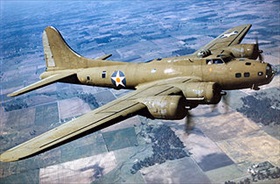 | 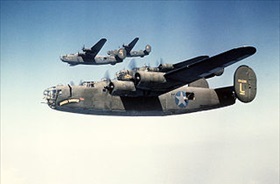 |
Left: Boeing B-17E Flying Fortress in flight. A total of 12,731 Flying Fortresses were built between 1935 and 1945. B‑17s flew with the U.S., British, and Soviet air forces. The German Luftwaffe even flew a dozen captured ones. B‑17s were armed with 13 .50 caliber/12.7 mm M2 Browning machine guns in 8 positions. Depending on the distance of the mission, a B‑17 could carry between 4,000 and 8,000 lb/1.8 and 3.6 metric tons of bombs. More bombs were dropped by B‑17s than by any other U.S. aircraft in World War II. Of the 1.5 million metric tons of bombs dropped on Nazi Germany and its occupied territories by U.S. aircraft, 640,000 tons were dropped from B‑17s.
Right: Consolidated B-24D Liberators of the 93rd Bomb Group in flight formation. A total of 18,482 B‑24 Liberators were built by September 1945. The B‑24 was armed with ten .50 caliber/12.7 mm M2 Browning machine guns in 4 turrets and 2 waist positions. Depending on the distance of the mission, the B‑24 could carry between 5,000 and 8,000 lb/2.5 and 3.6 metric tons of bombs. It was faster, had longer range, and could carry a ton more bombs than the B‑17, but Liberators formed only about one‑third of the heavy bomber strength of the U.S. Eighth Air Force. Flying from bases in England, thousands of B‑24s dropped hundreds of thousands of tons of high-explosive and incendiary bombs on German military and industrial targets. Liberators were also credited in full or in part with 93 U‑boat sinkings.
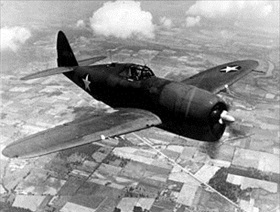 | 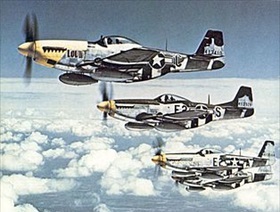 |
Left: The first U.S. fighter plane that would be used most extensively over the skies of Europe was the Republic P‑47 Thunderbolt in 1943. Nicknamed “the Jug” because of its profile to a milk bottle of the time, it was joined in the sky in 1944 by the North American P‑51 Mustang. Republic built 15,660 P‑47 Thunderbolts. The fighter was heavily armed with 8 .50 caliber/12.7 mm machine guns, 4 per wing. Powered by a Pratt & Whitney R‑2800 Double Wasp engine, it was very effective as a short-to-medium range escort fighter in high-altitude air-to-air combat. The P‑47s of the 56th Fighter Group had more air-to-air kills than any other fighter group in the Eighth Air Force and recorded the second-highest number of air-to-air kills of any USAAF fighter group. The 56th also claimed 311 enemy fighters destroyed on the ground.
Right: “The Bottisham Four,” a famous photo showing 4 U.S. Army Air Forces North American P‑51 Mustang fighters from the 375th Fighter Squadron, 361st Fighter Group, from RAF Bottisham, Cambridgeshire, in flight on July 26, 1944. North American built more than 15,000 of these P‑51s. Powered by a Packard V‑1650‑7 liquid-cooled supercharged V‑12, 1,490‑hp engine (a license-built version of the British Rolls-Royce Merlin 66 engine), the P‑51 was armed with 6 .50 caliber/12.7 mm machine guns, bombs, and rockets. Conceived originally as a dive bomber, the P‑51 Mustang was perhaps the finest American fighter plane of World War II. With an external drop tank attached to its belly, it became a long-range fighter escort. The Royal Air Force also flew squadrons of P‑51 long-range fighters, which along with their iconic Supermarine Spitfires provided escort for Eighth Air Force bomber formations over Europe. As many as 1,000 fighters accompanied upwards of 2,000 4‑engine bombers on a single mission to multiple targets in the last year of the war.

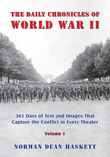 History buffs, there is good news! The Daily Chronicles of World War II is now available as an ebook for $4.99 on Amazon.com. Containing a year’s worth of dated entries from this website, the ebook brings the story of this tumultuous era to life in a compelling, authoritative, and succinct manner. Featuring inventive navigation aids, the ebook enables readers to instantly move forward or backward by month and date to different dated entries. Simple and elegant! Click
History buffs, there is good news! The Daily Chronicles of World War II is now available as an ebook for $4.99 on Amazon.com. Containing a year’s worth of dated entries from this website, the ebook brings the story of this tumultuous era to life in a compelling, authoritative, and succinct manner. Featuring inventive navigation aids, the ebook enables readers to instantly move forward or backward by month and date to different dated entries. Simple and elegant! Click 
